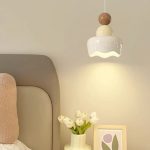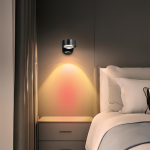Lighting Kneson plays a crucial role in interior design, and it can greatly impact the ambiance and functionality of a living room. The right lighting can create a warm and inviting atmosphere, enhance the overall design aesthetic, and even improve productivity and well-being. On the other hand, poor lighting choices can make a space feel dull, uninviting, and even affect our mood negatively. Therefore, understanding the importance of lighting in your living room is essential for creating a space that is both visually appealing and functional.
Key Takeaways
- Lighting plays a crucial role in creating a comfortable and inviting living room atmosphere.
- Choosing the right type of lighting, such as ambient, task, and accent lighting, can enhance the functionality and aesthetics of your living room.
- Layering your lighting with different fixtures and sources can create a dynamic and versatile space.
- Maximizing natural light through window treatments and furniture placement can improve the overall lighting in your living room.
- Accent lighting, such as wall sconces and table lamps, can add depth and dimension to your living room design.
Understanding the Importance of Lighting in Your Living Room
Lighting has the power to influence our mood, productivity, and overall well-being. The type of lighting we choose can have a significant impact on how we feel in a space. For example, bright and cool lighting can promote alertness and productivity, making it ideal for a home office or study area. On the other hand, warm and dim lighting can create a cozy and relaxing atmosphere, perfect for a living room or bedroom.
There are different types of lighting that serve different purposes. Ambient lighting provides overall illumination to a space and is usually the primary source of light in a room. Task lighting is focused on specific areas where activities such as reading or cooking take place. Accent lighting is used to highlight specific objects or architectural features in a room. Understanding these different types of lighting and their purposes is crucial for creating a well-lit living room that meets your needs.
Choosing the Right Type of Lighting for Your Living Room
When it comes to choosing the right type of lighting for your living room, there are several factors to consider. First, think about the function of the space. Do you primarily use your living room for entertaining guests, watching TV, or reading? This will help determine the type of lighting fixtures you need.
There are various types of lighting fixtures to choose from, including chandeliers, pendant lights, recessed lights, floor lamps, and table lamps. Each type of fixture serves a different purpose and can create a different ambiance in your living room. For example, a chandelier can add elegance and drama to a space, while recessed lights provide a clean and modern look.
Consider the size of your living room when selecting lighting fixtures. A large living room may require multiple light sources to ensure even illumination throughout the space. On the other hand, a small living room may benefit from a single statement fixture or a combination of smaller fixtures.
The Art of Layering Your Living Room Lighting
| Lighting Technique | Description |
|---|---|
| Ambient Lighting | Provides overall illumination to the room and sets the mood. |
| Task Lighting | Directs light to a specific area for a particular task, such as reading or cooking. |
| Accent Lighting | Highlights a particular object or area, such as a piece of artwork or a plant. |
| Dimmer Switches | Allows you to adjust the brightness of the lights to create different moods and atmospheres. |
| Layering | Combining different types of lighting to create a balanced and visually appealing effect. |
Layering different types of lighting is an effective way to create a more dynamic and inviting living room. By combining ambient, task, and accent lighting, you can achieve a well-balanced and visually appealing space.
Start by installing ambient lighting fixtures, such as overhead lights or recessed lights, to provide overall illumination. This will ensure that the entire room is well-lit. Next, add task lighting in areas where specific activities take place, such as reading nooks or workspaces. This can be achieved with table lamps or floor lamps that provide focused light.
Finally, incorporate accent lighting to add depth and dimension to your living room. This can be achieved with wall sconces, track lighting, or picture lights that highlight artwork or architectural features. By layering these different types of lighting, you can create a more inviting and visually interesting living room.
Maximizing Natural Light in Your Living Room
Natural light is not only beneficial for our well-being but also adds a sense of warmth and openness to a space. Maximizing natural light in your living room can make it feel brighter and more spacious.
Start by arranging your furniture in a way that allows natural light to flow freely into the room. Avoid placing large pieces of furniture in front of windows or blocking them with heavy curtains. Instead, opt for lightweight curtains or blinds that can be easily opened to let in natural light.
Consider using reflective surfaces, such as mirrors or glass, to bounce natural light around the room. This can make the space feel brighter and more open. Additionally, choose light-colored furniture and accessories that can reflect natural light and make the room appear larger.
Accent Lighting: Adding Depth and Dimension to Your Living Room

Accent lighting is a great way to add visual interest and depth to your living room. It can highlight specific objects or architectural features, creating a focal point in the space.
There are several ways to incorporate accent lighting in your living room. For example, you can use wall sconces to highlight artwork or create a dramatic effect on a feature wall. Track lighting is another option that allows you to direct light onto specific areas or objects.
Consider using LED strip lights under shelves or behind furniture to create a soft and indirect glow. This can add a sense of depth and dimension to your living room. Additionally, consider using table lamps with adjustable shades that can be directed towards specific objects or areas.
The Role of Color Temperature in Living Room Lighting Design
Color temperature refers to the warmth or coolness of light. It is measured in Kelvin (K) and can greatly affect the mood and ambiance of your living room.
Warm white light, with a color temperature of around 2700K-3000K, creates a cozy and inviting atmosphere. It is ideal for living rooms where relaxation and comfort are desired. On the other hand, cool white light, with a color temperature of around 4000K-5000K, creates a bright and energizing atmosphere. It is suitable for areas where productivity and focus are important, such as home offices or study areas.
When selecting the right color temperature for your living room lighting, consider the function of the space and the mood you want to create. You can also experiment with different color temperatures by using smart lighting technology that allows you to adjust the color temperature according to your needs.
Lighting Fixtures: Choosing the Right Size and Style for Your Living Room
When it comes to selecting lighting fixtures for your living room, size and style are important considerations. The size of the fixture should be proportionate to the size of the room and the height of the ceiling.
In general, larger rooms can accommodate larger fixtures, such as chandeliers or pendant lights. However, be mindful of the height of the ceiling. A low ceiling may require a flush mount or semi-flush mount fixture to avoid overwhelming the space.
Consider the style of your living room when selecting lighting fixtures. If you have a modern or contemporary living room, sleek and minimalist fixtures may be more suitable. On the other hand, if you have a traditional or eclectic living room, ornate or vintage-inspired fixtures can add character and charm.
Smart Lighting: Using Technology to Enhance Your Living Room Experience
Smart lighting technology allows you to control your lighting fixtures using your smartphone or voice commands. It offers a range of benefits, including convenience, energy efficiency, and customization.
With smart lighting, you can easily adjust the brightness and color temperature of your lights to create different moods in your living room. You can also set schedules or timers to automate your lighting based on your daily routine.
Additionally, smart lighting can help you save energy by allowing you to turn off lights remotely or set them to automatically dim when not in use. This can result in significant energy savings over time.
There are different types of smart lighting technology available, including smart bulbs, smart switches, and smart plugs. Each type offers different features and benefits, so it’s important to choose the one that best suits your needs and preferences.
Creating a Cozy Ambiance with Dimmer Switches and Lampshades
Dimmer switches and lampshades are simple yet effective ways to create a cozy and inviting ambiance in your living room. Dimmer switches allow you to adjust the brightness of your lights, giving you control over the mood and atmosphere of the space.
By installing dimmer switches, you can easily transition from bright and energizing lighting for daytime activities to soft and warm lighting for relaxation in the evening. This can create a more comfortable and cozy environment in your living room.
Lampshades also play a role in creating a cozy ambiance. They can diffuse light and soften its intensity, creating a warm and inviting glow. Choose lampshades that complement the style of your living room and allow light to pass through while providing a soft and diffused illumination.
Maintenance and Care: Keeping Your Living Room Lighting in Top Shape
Regular maintenance and care are essential for keeping your living room lighting fixtures in top shape. This not only ensures their longevity but also helps maintain their performance and appearance.
Start by dusting your lighting fixtures regularly to remove any dirt or debris that may accumulate over time. Use a soft cloth or a feather duster to gently wipe the surfaces of the fixtures.
For glass or crystal fixtures, use a glass cleaner or a mixture of water and vinegar to remove any smudges or fingerprints. Be sure to follow the manufacturer’s instructions for cleaning specific materials or finishes.
Check the bulbs regularly and replace them as needed. Burnt-out bulbs not only affect the performance of your lighting fixtures but can also create an unbalanced look in your living room.
In conclusion, lighting plays a crucial role in interior design, particularly in the living room. It can greatly impact the ambiance and functionality of the space, as well as our mood, productivity, and overall well-being. By understanding the importance of lighting and making informed choices, you can create a living room that is both visually appealing and functional.
Consider the different types of lighting and their purposes, and choose fixtures that meet your needs and preferences. Layer different types of lighting to create a dynamic and inviting space. Maximize natural light by arranging furniture and using window treatments strategically. Incorporate accent lighting to add depth and dimension to your living room. Pay attention to color temperature, lighting fixture size, and style to create the desired atmosphere. Explore smart lighting technology to enhance the functionality and customization of your living room lighting. Use dimmer switches and lampshades to create a cozy ambiance. Finally, maintain and care for your lighting fixtures regularly to ensure their longevity and performance.
By following these tips and considering the importance of lighting in your living room design, you can create a space that is not only visually stunning but also enhances your overall well-being.
If you’re looking to enhance the ambiance of your living room, proper lighting is key. In fact, it can make all the difference in creating a cozy and inviting space. To learn more about how to effectively light your living room, check out this informative article from Artis Home Gallerie: “Using a Wall Lamp in Your Bedroom”. Discover how incorporating a wall lamp can not only add functionality but also elevate the overall aesthetic of your living room.


